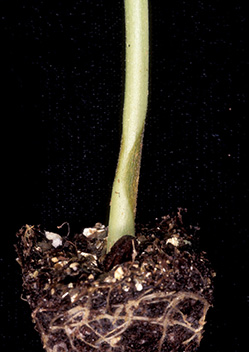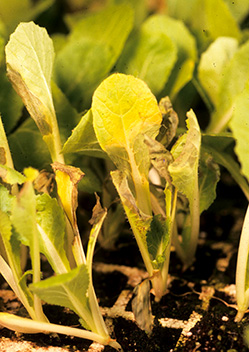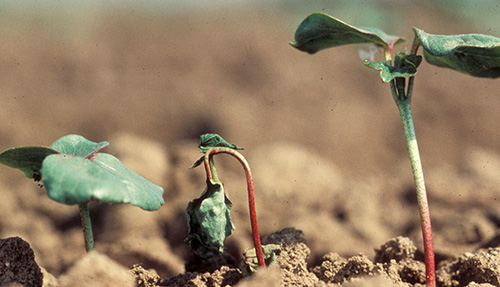Disease or disorder: How do I tell the difference? Part 2
Recognizing diseases on vegetable transplants in the greenhouse can improve your scouting. A prerecorded webinar on vegetable diagnostics is available at the Online IPM Academy.
Scouting your vegetable plants in the greenhouse and field will help you identify potential issues early on. In most cases, the earlier you detect an issue, the more effective the management tactics can be. But what are the differences between a disease and a disorder?
Let’s focus identifying diseases in the greenhouse. There are multiple pathogens that cause damping off in seedlings, including Pythium spp., Phytophthora spp. and Rhizoctonia spp. Damping off is a term that describes when a pathogen infects the roots and parts close to the soil line, delaying growth but ultimately resulting in seedling death.



Symptoms of damping off. Rhizoctonia damping-off, blight and rot (Rhizoctonia solani) on watermelon seedlings (top left) and Chinese cabbage seedlings (top right). Damping off on cotton seedlings in the field (bottom). All photo credits: Gerald Holmes, California Polytechnic State University at San Luis Obispo, Bugwood.org
Vegetable transplant diseases will depend on the crop. The table below lists the most important diseases on vegetable transplants in Michigan. Click on the disease name and the link will direct you to a symptom image to help with scouting.
Vegetable transplant diseases in Michigan
|
Tomatoes/Peppers |
|
|
Disease name |
Bacterial pathogen |
|
Ps. syringae pv tomato |
|
|
X. campestris pv vesicatoria |
|
|
Clavibacter michiganensis subsp. michiganensis |
|
|
Disease name |
Fungal pathogen |
|
Alternaria solani |
|
|
Botrytis cinerea |
|
|
Fulvia fulva |
|
|
Disease name |
Oomycete pathogen |
|
Phytophthora infestans |
|
|
Disease name |
Viral pathogen |
|
Tobacco mosaic virus (TMV) |
Tobacco mosaic virus (TMV) |
|
Cabbage-cole crops |
|
|
Disease name |
Bacterial pathogen |
|
Ps. syringae pv maculicola |
|
|
Ps. syringae pv alisalensis |
|
|
X. campestrisi pv campestris |
|
|
Disease name |
Fungal pathogen |
|
Damping off and wire stem |
Thanatephorus cucumeris |
|
Alternaria leaf spot/head rot |
Alternaria brassicae |
|
Alternaria brassicicola |
|
|
Disease name |
Oomycete pathogen |
|
Peronospora parasitica |
|
|
Damping off |
Phytophthora or Pythium |
|
Celery |
|
|
Disease name |
Bacterial pathogen |
|
Ps. syringae pv appi |
|
|
Disease name |
Fungal pathogen |
|
Cercospora apii |
|
|
Colletotrichum acutatum |
|
|
Disease name |
Oomycete pathogen |
|
Damping off, root rot |
Pythium spp. |
Preventative management tactics are the best approach to manage diseases. Planting pathogen-free seed and managing irrigation will keep fungal and bacterial diseases to a minimum for vegetable transplants.
To eradicate seed-borne bacterial pathogens, use hot water and chlorine treatments on vegetable seeds. “Hot Water and Chlorine Treatment of Vegetable Seeds to Eradicate Bacterial Plant Pathogens” and “Hot Water Treatment of Vegetable Seeds to Eradicate Bacterial Plant Pathogens in Organic Production Systems” by Ohio State University’s Sally Miller will provide the steps necessary to treat seed properly for conventional and organic production systems. Treatment is a function of time and chlorine concentration. Care must be taken to avoid seed damage. It would be best to practice on small seed lots and understand the procedure before moving into larger batches.
Early morning irrigation and increased airflow will minimize leaf wetness conducive to disease development on high-density plug trays. Once transplanted in the field, avoid overwatering vegetable seedlings.
If symptoms arise in the greenhouse or the field, make sure you consider the fertility program and have learned to recognize disorders on vegetable transplants in the greenhouse. If you have additional questions, find an MSU Extension expert or collect and send samples to MSU Diagnostic Services. Remember, correct diagnosis is the first step to effective disease management.
Learn more about IPM basics, scouting guides and more at the Online Integrated Pest Management (IPM) Academy. Among the webinars Michigan State University Extension is offering at the Online IPM Academy website, the webinar titled “What is wrong with my vegetable plants?” discusses the differences between vegetable diseases and disorders. Accommodations for persons with disabilities may be requested by contacting Erin Lizotte with MSU Extension at taylo548@msu.edu to make arrangements. Requests will be fulfilled when possible.
For Part 1 of this series, see “Disease or disorder: How do I tell the difference? Part 1.”
Additional resources



 Print
Print Email
Email



